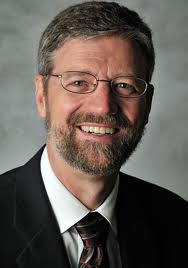 Ervin Stutzman is executive director of Mennonite Church USA
Ervin Stutzman is executive director of Mennonite Church USA
Holidays like Christmas often bring families together. And when families get together, photos are often a part of the interaction. I’m particularly intrigued by family portraits, whether formal or informal.
You’ve surely had the experience of gazing at a family portrait taken years ago and marveling how different the same group looks today. “Wow, look at Dad. He didn’t even have any gray hair back then.”
It’s helpful to think of the recent survey of credentialed leaders as a family portrait. It captures a moment in time—August 2014. I’m thrilled that so many chose to be in the picture. Out of 2,000 potential respondents, 1,323, or 66.2%, responded to the questions. I’m grateful for all those who invested the time and energy to complete the survey.
You might ask what prompted us to produce this survey. We did it to “get a better picture” of the profile of credentialed leaders in Mennonite Church USA. Rather than guessing where people would put themselves in a group profile, we invited everyone to speak for themselves. As a result, we have a rich group portrait. I can only imagine what we might say when we look back at it several decades from now.
I’m grateful for Conrad Kanagy, who made this group portrait for us. His executive summary highlights many of the primary findings of the survey. But Kanagy’s longer summary compares this group portrait with one taken in 2006. The pastors in Mennonite Church USA have clearly changed their looks in less than a decade. So you might want to note those changes.
As always in families, some dynamics change while others remain the same. Kanagy’s portrait divides the family into three area conference groups that reflect different demographics as well as personal convictions on issues of LGBTQ inclusion. Demographics matter, not only to a sociologist, but to credentialed leaders in Mennonite Church USA.
Some of us might not be happy with what we see in this family portrait. The story is told of a disappointed client who lashed out at the photography studio: “That picture doesn’t do me justice!” Yet, I suppose if we were totally honest, most of us prefer mercy to justice when it comes to the way we look in portraits. In the pixilated universe we inhabit, we appreciate the ability to “Photoshop” our photos to remove the blemishes, warts or wrinkles that inevitably show up as we grow older. As Parker Palmer reminds us, we often experience a “tragic gap” between what we are, and what we aspire to be.
On the other hand, as the old saying goes, “You see what you’re looking for.” As I studied the portrait, I looked for signs of hopefulness and for the positive ways that congregations benefit from the broader connections they make in Mennonite Church USA. I found a good deal of hope there, in spite of our imperfections.
As we gaze at the portrait, we might be tempted to blame Kanagy for flaws in this interpretation, his reading of the pixels. If so, it might be helpful to look at the portrait along with other observers. You might ask: “What stands out to you in this picture?” “What seems a little fuzzy?”
In the “photo gallery” of Mennonite Church USA in my office, this most recent survey hangs next to three other group portraits, with some of the same people in them. First in line is the portrait of Eastern Mennonite University, taken by survey of faculty and staff, students, parents, donors, alums, and other constituents, early in 2014. The second is a survey of credentialed leaders in Lancaster Mennonite Conference this summer. The third is a survey of members in the Western District, also this summer. It’s well worth the time to gaze at each of these group portraits; separately as well as together. Each contributes something to our understanding of the church we call Mennonite Church USA.
It’s important to know that each of the four surveys promised anonymity and confidentiality to the respondents. From long experience, the survey designers were confident that people would “look more natural” if they weren’t worried about being singled out or blamed for their responses. So I’m confident that, at least for the folks who showed up for the portraits, we have a fairly accurate picture of those who responded.
Since I’m fascinated by these group portraits, I’m making space in my gallery for the one that Kanagy will be painting next spring. The Executive Board intends to sponsor a survey of representatives from congregations and conferences who intend to serve as delegates at our biennial denominational assembly at Kansas City in July, 2015. In other words, the groups who appoint delegates will determine who gets to be in the picture. For purposes of comparison, we’ll be asking some of the same questions as we did in the survey of credentialed leaders. For purposes of planning for the delegate sessions, we will ask some unique questions as well. The entire survey will be available in both Spanish and English.
Again, I offer a special word of thanks to those who gave the time and effort to get into the portrait. I intend to contemplate what I’m seeing there for some time to come.

